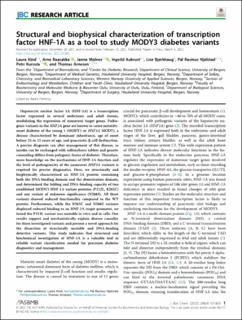| dc.contributor.author | Kind, Laura | |
| dc.contributor.author | Raasakka, Arne | |
| dc.contributor.author | Molnes, Janne | |
| dc.contributor.author | Aukrust, Ingvild | |
| dc.contributor.author | Bjørkhaug, Lise | |
| dc.contributor.author | Njølstad, Pål Rasmus | |
| dc.contributor.author | Kursula, Petri | |
| dc.contributor.author | Arnesen, Thomas | |
| dc.date.accessioned | 2022-06-30T06:45:42Z | |
| dc.date.available | 2022-06-30T06:45:42Z | |
| dc.date.created | 2022-04-19T10:12:03Z | |
| dc.date.issued | 2022 | |
| dc.identifier.issn | 0021-9258 | |
| dc.identifier.uri | https://hdl.handle.net/11250/3001666 | |
| dc.description.abstract | Hepatocyte nuclear factor 1A (HNF-1A) is a transcription factor expressed in several embryonic and adult tissues, modulating the expression of numerous target genes. Pathogenic variants in the HNF1A gene are known to cause maturity-onset diabetes of the young 3 (MODY3 or HNF1A MODY), a disease characterized by dominant inheritance, age of onset before 25 to 35 years of age, and pancreatic β-cell dysfunction. A precise diagnosis can alter management of this disease, as insulin can be exchanged with sulfonylurea tablets and genetic counseling differs from polygenic forms of diabetes. Therefore, more knowledge on the mechanisms of HNF-1A function and the level of pathogenicity of the numerous HNF1A variants is required for precise diagnostics. Here, we structurally and biophysically characterized an HNF-1A protein containing both the DNA-binding domain and the dimerization domain, and determined the folding and DNA-binding capacity of two established MODY3 HNF-1A variant proteins (P112L, R263C) and one variant of unknown significance (N266S). All three variants showed reduced functionality compared to the WT protein. Furthermore, while the R263C and N266S variants displayed reduced binding to an HNF-1A target promoter, we found the P112L variant was unstable in vitro and in cells. Our results support and mechanistically explain disease causality for these investigated variants and present a novel approach for the dissection of structurally unstable and DNA-binding defective variants. This study indicates that structural and biochemical investigation of HNF-1A is a valuable tool in reliable variant classification needed for precision diabetes diagnostics and management. | en_US |
| dc.language.iso | eng | en_US |
| dc.publisher | Elsevier | en_US |
| dc.rights | Attribution-NonCommercial-NoDerivatives 4.0 Internasjonal | * |
| dc.rights.uri | http://creativecommons.org/licenses/by-nc-nd/4.0/deed.no | * |
| dc.title | Structural and biophysical characterization of transcription factor HNF-1A as a tool to study MODY3 diabetes variants | en_US |
| dc.type | Journal article | en_US |
| dc.type | Peer reviewed | en_US |
| dc.description.version | publishedVersion | en_US |
| dc.rights.holder | Copyright 2022 The Authors | en_US |
| dc.source.articlenumber | 101803 | en_US |
| cristin.ispublished | true | |
| cristin.fulltext | original | |
| cristin.qualitycode | 2 | |
| dc.identifier.doi | 10.1016/j.jbc.2022.101803 | |
| dc.identifier.cristin | 2017476 | |
| dc.source.journal | Journal of Biological Chemistry | en_US |
| dc.identifier.citation | Journal of Biological Chemistry. 2022, 298 (4), 101803. | en_US |
| dc.source.volume | 298 | en_US |
| dc.source.issue | 4 | en_US |

